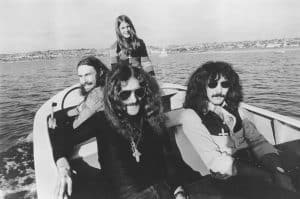They Were Just Trying to Play a Show — Then Disaster Struck

via Dektopika / YouTube
There’s always a different kind of excitement when you hear about your favorite band going on tour. Maybe right after the announcement, you rush to see if they’re playing near you. You start arranging a road trip or praying for more dates to come up. You enter contests and scramble for tickets, hoping for front-row seats. But for bands and artists, touring isn’t all fun and games. They go from city to city, sometimes with only a little time to breathe. Traveling all the time, having to stick to tight schedules, and being tired all the time can be hard. Then there are incidents where things can go unexpectedly wrong. Some tours have ended in tragedy, which shows us how hard it is to be on the road.
Metallica
In the early hours of September 27, 1986, Metallica was on the road in Sweden, promoting their game-changing album Master of Puppets. They were headed to their next gig when tragedy struck. Around 7 a.m., their tour bus hit a patch of black ice, lost control, and flipped. Bassist Cliff Burton was thrown through a window — and when the bus landed, it tragically crushed him. He was just 24. Different people on the scene gave slightly different versions of what happened next, but they all agree on one heartbreaking fact: Cliff didn’t survive. An investigation followed, but the driver was ultimately cleared of wrongdoing.
James Hetfield later recalled the awful moment, saying, “Coming out and finding your buddy under the bus is not something you want to go through… Why did this happen?” The most haunting part? Cliff wasn’t even supposed to be in that bunk. He’d won it from Kirk Hammett in a simple card draw — pulling the ace of spades. That one card sealed his fate.
Stevie Ray Vaughan
Stevie Ray Vaughan’s In Step Tour was a massive 136-show run that kicked off on May 4, 1989. It all came to a close with a legendary performance alongside Eric Clapton at Wisconsin’s Alpine Valley Music Theater. But what should’ve been a triumphant night ended in tragedy. After the show, four helicopters were lined up to take the musicians and crew back to Chicago. One of those choppers had been set aside for Stevie, his brother Jimmie, and Jimmie’s wife — but when some of Clapton’s team boarded it first, Stevie took the last open seat.
The next morning, panic set in. The helicopter never made it to Chicago. Stevie’s hotel room was empty. By 7 a.m., Jimmie Vaughan received the devastating call to identify his brother’s body. The helicopter had crashed just half a mile from takeoff, slamming into a ski slope in thick fog. Even more haunting? Just the day before, Stevie had told his bandmates he’d dreamed of watching his own funeral.
Dropkick Murphys
Late 2014 was a heartbreaking time for Celtic punk band Dropkick Murphys. On November 13, frontman Al Barr shared that he had just lost a childhood friend and would be missing their upcoming show in Tulsa, Oklahoma, to attend the funeral. But the sadness didn’t stop there.
While traveling to the airport, tragedy struck again. The band’s tour bus was involved in a fatal accident, hitting a pedestrian who suddenly ran into the road. The Tulsa show was immediately canceled, and the band shared the devastating news with fans, expressing deep sorrow and asking for prayers for the victim’s family.
The Boston Globe later reported that the man was a 23-year-old father. The crash happened on Interstate 35, just north of Austin, Texas. As the band grieved and tried to process what had happened, the victim’s family showed incredible compassion, offering their condolences to the Dropkick Murphys and their driver. It was a painful moment no one involved would ever forget.
Ozzy Osbourne
By the early ’80s, Ozzy Osbourne was finding his groove again after being kicked out of Black Sabbath in 1979. A huge part of that comeback was thanks to guitarist Randy Rhoads. Ozzy often credited Rhoads for saving his career — which made what happened next all the more devastating. In 2018, Ozzy recalled the tragedy, saying, “To this day, as I’m talking to you now, I’m back in that field looking at this f\*cking plane wreck and a house on fire. You never get over something like that.”
It wasn’t just a freak accident — it was surreal. Their bus driver, Andrew Aycock, who had an expired pilot’s license, took Rhoads and makeup artist Rachel Youngblood on a short flight in a small 1955 Beechcraft plane. While Ozzy and the rest of the band slept on the bus, Aycock buzzed them from above before losing control. The plane clipped a tree and crashed into a house, killing all three instantly.
The crash hit everyone hard. Bassist Rudy Sarzo quit soon after, saying, “It was so painful to go onstage without Randy.” But Sharon Osbourne urged them to keep going — and within 10 days, they were back on the road with guitarist Bernie Tormé.
Gary Numan
In early 2018, Gary Numan announced a second leg of his tour to support his 22nd album, Savage (Songs from a Broken World). Things were going strong, and fans were excited to see the synth-pop legend back on stage. But in September of that year, just before a scheduled performance at the House of Blues in Cleveland, tragedy struck.
As reported by Rolling Stone, Numan’s tour bus was turning right when it hit a 91-year-old man who was pushing a cart across a crosswalk. The man was killed instantly, and a priest from a nearby church came to deliver last rites at the scene.
Deeply shaken, Numan canceled the show and released a heartfelt statement: “We are all utterly devastated by the fatal accident involving our tour bus earlier today… out of respect it would have been entirely wrong [to perform]. All we can think about are the people affected by this terrible tragedy, and to them we send our love.”
Buddy Holly
February 3, 1959, became known as the Day the Music Died — a heartbreaking moment that changed rock and roll forever. Buddy Holly, just 22, was already a major influence, inspiring legends like The Beatles, Bob Dylan, and Elton John. That night, he was flying out after a concert in Iowa, joined by fellow rising stars Ritchie Valens and J.P. “The Big Bopper” Richardson.
They were all part of the Winter Dance Party Tour, a whirlwind series of shows across the Midwest. The music was great, but the travel? Miserable. Their tour bus kept breaking down in the freezing cold, so Holly decided to charter a small plane to the next stop. Valens got his seat by winning a coin toss. Richardson, sick with the flu, got a spot after Waylon Jennings gave his up.
Right before takeoff, Holly joked to Jennings, “I hope your damned bus freezes up again.” Jennings replied, “I hope your ol’ plane crashes.” That haunting exchange stayed with him forever. Tragically, the plane crashed shortly after takeoff. No one survived.
Lynyrd Skynyrd
Just days after releasing their now-iconic album Street Survivors, Lynyrd Skynyrd boarded a beat-up, 30-year-old Convair 240 for a flight that would change everything. The tour was off to a strong start — five shows in and spirits were high — but that old plane had already raised serious red flags. Still, despite engine troubles and growing concern among the crew, they flew on.
According to Rolling Stone, the band was planning to switch to a Learjet soon, and the flight from Greenville to Baton Rouge was supposed to be one of their last on the aging Convair. It was — just not in the way they had hoped.
Nearly everyone on board had a bad feeling. Flames had even been spotted shooting from the engine days earlier. But Ronnie Van Zant, determined to press on, reportedly said, “Hey, if the Lord wants you to die on this plane, when it’s your time, it’s your time. Let’s go, man. We’ve got a gig to do.” A few hours later, the plane crashed in Mississippi. Ronnie, Steve Gaines, and Cassie Gaines didn’t make it. Chillingly, Van Zant had long believed he wouldn’t live past 30 — and he was just months away.
Reba McEntire
Sometimes, one simple choice changes everything. For Reba McEntire, that moment came in 1991. After finishing a concert in San Diego, she and her husband decided to stay one more night in California, while the rest of her band flew ahead to their next show in two separate planes.
The second plane landed safely. But the first one never made it. Just 10 miles from its destination, the aircraft struck the side of Otay Mountain after one of its wings clipped a rocky outcrop. All eight people onboard—Reba’s close friends and longtime bandmates—were killed in the crash.
In the aftermath, fellow country stars offered their own bands to help Reba continue her tour, but she turned them down. Instead, she honored her loss through music, dedicating her next album, For My Broken Heart, to the band she lost. On the 25th anniversary, Reba visited the crash site and wrote: “I feel in my heart that they know we still miss them so much. My love and prayers to all the families and friends.”
Gloria Estefan
Some people have the strength to turn heartbreak into something meaningful—and Gloria Estefan is one of them. In 1990, while on the road to Syracuse, her tour bus was rear-ended in a devastating crash. The injuries were severe—she broke her back and was told she might never walk again, let alone perform. Years later, she opened up about the trauma on Oprah’s Next Chapter, saying, “Those things can… tear you apart. It’s hard to handle.”
Her recovery was brutal. Gloria credits her husband for helping her through nine months of intense rehab—seven hours a day, every day. She couldn’t even sleep more than 45 minutes at a time because of the pain. But something shifted in her mindset. “At first, I just wanted to walk again,” she said. “Then I thought, maybe this was the point of becoming famous—to go through something like this publicly and show people the power we have to change our destiny.”
Since then, Estefan has become a powerful advocate for spinal cord research, raising awareness and funding to help others facing similar battles.
Trace Adkins
In 2010, Trace Adkins was already at the CenturyTel Center in Bossier City, Louisiana, getting ready for his show when he got heartbreaking news — his tour bus had been in a terrible crash just north of Shreveport. Five of his band members were on board. Thankfully, their injuries were minor, but the crash claimed the lives of two men in a Ford F-250 that collided head-on with the bus.
According to investigators, the truck had been swerving before impact, and the bus driver couldn’t avoid the crash. The cause was ruled as driver fatigue — the two men had reportedly been awake for nearly 24 hours after pulling an all-nighter at a local casino.
Despite the shock and grief, Adkins chose to go on with a stripped-down version of his performance that night, honoring the moment with a quieter tone. He later canceled his upcoming Pensacola show out of respect for the victims and to give everyone time to recover emotionally from the tragedy.
Otis Redding and the Bar-Kays
Otis Redding was just 26 years old and riding high when tragedy struck. The former well-digger turned soul superstar had recently knocked Elvis Presley out of the top spot as Melody Maker’s best male vocalist. He was finally seeing years of hard work pay off — and for the first time, he was flying on his own private plane during a tour. But just four miles from their destination, the Madison Municipal Airport in Wisconsin, the plane crashed into a fog-covered lake.
Only one person survived: Bar-Kays trumpet player Ben Cauley, who clung to a seat cushion to stay afloat. Fellow bandmate James Alexander had taken another flight that day and would later help rebuild the Bar-Kays. The loss was especially heartbreaking — most of the Bar-Kays were still in high school and had needed permission slips from their parents to join the tour.
Just three days before the crash, Redding had recorded what would become his most legendary song: “(Sittin’ On) The Dock of the Bay.” It was the last thing he left behind.
The Ghost Inside
In 2015, metalcore band The Ghost Inside was traveling from a show in Texas to their next stop in Phoenix when their tour took a tragic turn. Just outside El Paso, their bus was hit head-on by a semi-truck, leading to a devastating crash that changed their lives forever.
Early reports were unclear, but NME confirmed that both drivers were killed in the collision. Drummer Andrew Tkaczyk was badly hurt — his brother Nick later shared that Andrew had suffered major head trauma, a shoulder injury, and several broken bones. It wasn’t until later that fans learned Andrew had been in a coma for 10 days and had lost one of his legs.
Despite the odds, the band never gave up hope. By 2018, Digital Music News shared that a return to the stage might actually happen. Andrew got a prosthetic, and with the help of his dad — who built a special drum rig — he found a way to play again. In July 2019, The Ghost Inside made a triumphant comeback with a sold-out show at LA’s Shrine Auditorium.
Jim Croce
Jim Croce’s music career almost didn’t happen. After his first album with his wife Ingrid flopped, he walked away from music and took a construction job to make ends meet. But in 1972, ABC/Dunhill Records gave him another shot — and he made the most of it. His singles “You Don’t Mess Around with Jim” and “Operator” broke into the Top 20, leading to a full album and a chart-topping hit, “Bad, Bad Leroy Brown,” by April 1973. Just six months later, everything came to a sudden and tragic end.
Croce had been playing a series of college gigs, and after a show at Northwestern Louisiana University, he boarded a small chartered plane headed for Sherman, Texas. Moments after takeoff, the plane failed to gain enough altitude and crashed into a tree just 250 feet beyond the runway. All six people on board were killed, including Croce, who was only 30. The crash also claimed the lives of his guitarist Maurice Muehleisen, comedian George Stevens, manager Dennis Fast, booking agent Dominick Cortese, and pilot Robert Newton Elliott.
Rick Nelson
Rick Nelson was one of rock ‘n’ roll’s early stars and one of the first true teen idols. Singing hit songs on national TV each week on The Adventures of Ozzie and Harriet, where he starred alongside his real-life family, Nelson became a household name in the late ’50s with tracks like “I’m Walking,” “Poor Little Fool,” and “Lonesome Town.” Years later, he found a second wave of success with his 1972 country-rock hit “Garden Party,” which reminded fans he still had something to say.
But tragedy struck in December 1985. After performing in Guntersville, Alabama, Nelson and his band boarded a DC-3 aircraft en route to a New Year’s Eve show in Dallas. As the plane flew near De Kalb, Texas, it began circling. The pilot radioed in that there was a fire on board and attempted an emergency landing. Moments later, the plane crashed into a wooded area, hitting power lines and bursting into flames. The pilot and co-pilot survived with serious burns, but all seven passengers — including Nelson, his fiancée, and bandmates — were killed. He was just 45.
Chuck Mangione
In the late 1970s, soft rock had its smooth and silky heyday—and no one captured that vibe quite like Chuck Mangione. Known for his signature flugelhorn, Mangione brought jazz into the pop world with the instrumental hit “Feels So Good.” The tune, with its catchy melody and breezy, disco-tinged rhythm, climbed to No. 4 on the pop charts and became a staple of easy listening. Mangione wasn’t just a one-hit wonder, either—he made waves on the adult contemporary charts for years.
But on February 12, 2009, tragedy struck Mangione’s world. A flight heading from Newark, New Jersey, to Buffalo, New York, crashed just outside Buffalo, killing all 49 people on board. Among them were two of Mangione’s longtime bandmates—saxophonist Gerry Niewood and guitarist Coleman Mellett. The musicians were on their way to perform with Mangione and the Buffalo Philharmonic. Niewood, 64, had played with Mangione since the ‘60s, and Mellett, just 33, was a rising talent. The concert was canceled, and Mangione was left devastated by the sudden, heartbreaking loss.
Eddie Cochran
In the late 1950s, Eddie Cochran helped shape the sound of early rock ‘n’ roll with his raspy voice, catchy guitar riffs, and songs that captured teen rebellion and summertime vibes. Tracks like “Summertime Blues” and “C’mon Everybody” turned him into a rising star before he was even out of his teens. He blended rockabilly, country, and R\&B in a way that felt fresh, raw, and full of energy.
While rock ‘n’ roll was starting to fade from the U.S. charts in the early ‘60s, Cochran’s sound was still thriving in the U.K. That popularity led him to tour there with fellow rocker Gene Vincent. The tour was such a hit, they added 10 more weeks of shows. But tragedy struck on April 16, 1960. After a performance in Bristol, the two hired a cab to take them to the airport. Late that night, the car crashed near Chippenham. Vincent survived with injuries, but Cochran was thrown from the vehicle and died from a head injury. He was just 21 years old.
La Bouche
In the mid-1990s, La Bouche lit up dance floors around the world with hits like “Be My Lover” and “Sweet Dreams.” The high-energy duo was the brainchild of producer Frank Farian—yes, the same guy behind Milli Vanilli. He teamed up soulful Atlanta-born singer Melanie Thornton with rapper Lane McCray, and the chemistry was instant. After three successful albums with La Bouche, Thornton decided to go solo and found success overseas with the uplifting single “Ready to Fly.”
But just as her solo career was taking off, tragedy struck. On November 24, 2001—just two days before her next single, “Wonderful Dream,” was set to drop—Thornton was flying from Berlin to Zurich for a performance. As the plane neared its destination, it crashed into a forest near the airport. Sadly, all 24 people onboard lost their lives, including Thornton. She was only 33. Her powerful voice and infectious energy left a lasting mark on ‘90s pop, and her loss was deeply felt in the music world.
Her’s
Her’s was an indie band quickly gaining momentum in the late 2010s. After getting a boost from BBC Introducing, the duo dropped their debut album, Invitation to Her’s, in 2018 to a warm welcome from fans on both sides of the Atlantic. The band was made up of Stephen Fitzpatrick and Audun Laading, two talented musicians who met while studying at the Liverpool Institute for Performing Arts. Their dreamy, offbeat sound earned praise from critics, with The Guardian comparing them to acts like The Smiths and Aztec Camera.
In 2019, Her’s hit the road for a 19-date U.S. tour, eager to connect with fans face-to-face. After a show in Phoenix on March 26, they set out overnight in a van bound for their next stop in Santa Ana, California. Tragically, they never made it. In the early hours of March 27, their vehicle was hit head-on by a pickup truck. All three people in the van—Fitzpatrick, 24; Laading, 25; and their tour manager, Trevor Engelbrektson—were killed, along with the truck driver.
Khaotika and Wormreich
Khaotika and Wormreich were two fierce metal bands from the Southeast, each carving out their own lane in the heavy music scene. Khaotika described their sound as “melodic occult metal,” and released their debut Bloodline Empire in 2014. Wormreich leaned into a darker, black metal style and had been active since 2009, kicking things off with their album Edictvm DCLXVI. Though different in sound, both bands shared enough fans to hit the road together for a 2015 tour through the region that shaped them.
But tragedy struck after a show in Spartanburg, South Carolina. On the way to their next stop in Atlanta, the van carrying members of both bands veered off the road when the driver reportedly fell asleep at the wheel. The vehicle crashed into a tree, leaving eight people injured—three critically—and three others dead. Among those who died were Khaotika’s 25-year-old Nicholas Crisostomo and Wormreich’s Ian McKinney, 30, and Paul Truesdell, 29. The crash brought a heartbreaking end to a promising tour.
Decapitated
Decapitated burst onto the metal scene in 1996, forming in Poland and quickly earning a name for themselves in the world of technical death metal—a brutally fast and complex subgenre that demands serious skill. By the early 2000s, they were one of Poland’s top metal exports, known for their intense albums and jaw-dropping musicianship. Over time, the band went through some lineup changes, including the addition of seasoned metal vocalist Adrian “Coven” Kowanek, who stepped in after original frontman Wojciech “Sauron” Wasowicz left.
Tragedy struck in November 2007 during a tour through Russia. While traveling near the Belarus-Russia border, Decapitated’s tour bus collided with a lumber truck. Both Kowanek and drummer Witold “Vitek” Kiełtyka suffered severe head injuries. Kowanek fell into a coma and later experienced cardiac arrest, leading to brain damage and full paralysis. Vitek, just 23 years old, underwent emergency surgery but never recovered. He died from his injuries shortly after, cutting short a life and career filled with promise and power.
Bayside
Blending hard rock, punk, and emo, Bayside helped define the sound of the early 2000s alt-rock scene. Formed in the Bayside neighborhood of Queens, New York, in 2000, the band quickly gained momentum with a couple of EPs before signing with Victory Records. Their first two full-length albums followed, and the second one marked a big milestone—it landed them a spot on the Billboard charts and gave them a real shot at the spotlight.
But just weeks after that success, tragedy hit. While on tour with Hawthorne Heights and driving to their next show in Salt Lake City, the band’s van hit a patch of ice near Cheyenne, Wyoming. The van flipped and landed upside down. Bassist Nick Ghanbarian and drum tech Dan Marino suffered serious back injuries and needed surgery. Sadly, drummer John “Beatz” Holohan didn’t survive the crash. He was just 31. The accident left the band—and their fans—shaken, casting a shadow over what had been a rising career.
Chase
Bill Chase made a name for himself playing trumpet in the big bands of jazz legends like Stan Kenton and Woody Herman. But in the early ’70s, he struck out on his own, forming a high-energy jazz-rock band simply called Chase. With a lineup full of young, talented musicians and a bold, brassy sound, the group scored a few hits in 1971—most notably the trumpet-heavy jam “Get It On,” which climbed to No. 24 on the Billboard pop chart.
In August 1974, Chase was booked to play the Jackson County Fair in southwestern Minnesota. Half the band traveled ahead by road, while the other four members—including Chase himself—flew in from Chicago on a small two-engine plane. Tragically, on the evening of August 9, that plane crashed in a soybean field just a few miles from their destination. All six people on board were killed. Among the victims were the pilot, co-pilot, drummer Walt Clark, guitarist John Emma, organist Wallace Wohn, and bandleader Bill Chase. He was just 39.
Montgomery Gentry
Montgomery Gentry came together after Eddie Montgomery and Troy Gentry’s band, Young Country, split up—mainly because their lead singer, John Michael Montgomery (Eddie’s brother), launched a solo career. Blending country with a Southern rock edge, the duo quickly made waves in the late ’90s and 2000s. Their gritty sound and no-nonsense attitude earned them hits like “If You Ever Stop Loving Me,” “Lucky Man,” and “Back When I Knew It All,” all of which topped the country charts.
On September 8, 2017, Montgomery Gentry was scheduled to perform at the Flying W Airport and Resort in Medford, New Jersey. Eddie was already on the ground at the venue when Gentry opted to take a short helicopter ride over the area. Tragically, the chopper crashed near the runway just before the show. Both the pilot, James Evan Robinson, and 50-year-old Troy Gentry were killed. Gentry was rushed to a nearby hospital but didn’t survive. The loss shook the country music world and left a lasting hole in the band’s legacy.
Opeth
With their mix of progressive rock, crushing heavy metal, and haunting folk influences, Opeth carved out a unique sound that set them apart in the world of hard rock. Hailing from Sweden, the band rose to become one of the most respected and influential acts of the early 2000s, known for their dramatic, dark, and often beautiful compositions.
In 2009, Opeth was deep into a tour that took them across the British Isles, wrapping up that leg with a show in Dublin on October 13. After the concert, three band members flew home to Sweden for a short break, while bassist Martin Mendez and keyboardist Per Wiberg stayed behind and traveled with the tour bus to the next stop in Brussels.
While cruising at about 50 mph, their bus approached a car parked sideways across the road. The driver swerved to avoid it, but the car suddenly reversed into their path. The bus slammed into the vehicle, killing the lone occupant—a 35-year-old man—who had intentionally caused the crash in a suicide attempt. Miraculously, no one from Opeth’s crew was injured.
Damageplan
After Pantera split in the early 2000s, two of its biggest forces—guitarist “Dimebag” Darrell Abbott and his brother, drummer Vinnie Paul—wasted no time getting back to music. They launched a new band called Damageplan, and fans were pumped. Dimebag was already known as one of metal’s greatest guitarists, so there was major hype around their debut album and the tour that followed.
On December 8, 2004, Damageplan rolled into Columbus, Ohio, for a show at the small Alrosa Villa club. The crowd was packed with longtime Pantera fans—including 25-year-old Nathan Gale, a former Marine diagnosed with paranoid schizophrenia. Convinced the band had stolen his lyrics and identity, Gale brought a gun into the venue.
Less than two minutes into the show, he stormed the stage and opened fire. In a matter of seconds, he killed guitarist Dimebag Darrell, fan Nathan Bray, crew member Jeff Thompson, and venue employee Erin Halk. Dimebag was just 38. The night ended in horror, shaking the rock world to its core.
Exploding Hearts
Formed in Portland in 2001, the Exploding Hearts were all about bringing back that raw, catchy energy of late ’70s punk and power pop. Their sound was a perfect mix of punchy guitars, irresistible hooks, and New Wave flair. In 2003, as garage rock was making a comeback, they dropped Guitar Romantic—their first and only album with the original lineup. The record quickly earned them a cult following, and their West Coast tour had fans and critics buzzing about the band’s bright future.
But that promise was cut short on July 20, 2003. After a show in San Francisco, the band was driving back up Interstate 5 toward Portland when tragedy struck. About 100 miles from home, bassist Matt “Lock” Fitzgerald lost control of the van, which flipped twice before landing off the road. Fitzgerald, drummer Jeremy “Kid Killer” Gage, and frontman Adam “Baby” Cox were all thrown from the vehicle. Gage and Cox died at the scene; Fitzgerald passed away later at the hospital. Only guitarist Terry Six and their manager, Ratch Aronica, survived, with Six walking away with minor injuries.
Josh Turner
Josh Turner, known for his rich, deep voice and throwback country sound, has built a loyal fanbase across the country. A modern-day traditionalist, he channels the spirit of country legends with heartfelt songs and timeless style. In September 2019, Turner was out on the West Coast for a show in Paso Robles, California. After the concert, the crew prepared for their next stop—an upcoming gig at the Central Washington State Fair—by loading up into multiple vehicles. Most of the road crew traveled together on a tour bus.
Just 20 minutes outside of Paso Robles, tragedy struck. The bus veered off the highway, crossed a dirt shoulder, smashed through a fence, and plunged 50 feet into a dry riverbed near the small town of Shandon. The crash left seven people seriously injured. Sadly, crew member David Turner lost his life in the accident. The heartbreaking incident shook the entire touring team and cast a dark shadow over what had been a successful run of shows.
Christina Grimmie
Christina Grimmie rose to fame as a teenager with a powerhouse voice and a polished, emotional singing style. She first caught attention on YouTube, where her covers went viral, and later wowed audiences on The Voice. All four judges turned their chairs for her, and though she ultimately finished in third place, she became one of the show’s biggest breakout stars. Grimmie went on to release two albums, score four pop chart singles, and join the “All the Lights Tour” in 2016.
On June 10, 2016, after a show in Orlando, Florida, Grimmie stayed to meet fans during a post-show meet-and-greet. Among the crowd was 27-year-old Kevin Loibl, a disturbed fan who had developed a dangerous obsession. He reportedly told people he believed he and Grimmie were close and that they’d someday get married. Tragically, Loibl approached her and shot her at close range. Christina’s brother quickly tackled him, but Loibl broke free and took his own life. Christina Grimmie was just 22 years old—a rising star taken far too soon.












